
3 Ways Practicing Empathy Improves Team Effectiveness
- Admin
- Collaboration
- 20 Aug, 2024
In a previous post, we talked about toxic leadership, as the main culprit for why employees leave, and how to start fixing it. In this post, we’re going to dive deeper into one of the key traits that leaders practice and strengthen in order to become exceptional — empathy!
Empathy is the ability to feel what another person is feeling. It is the ability to put yourself in the other person’s shoes in a big and meaningful way. It is to experience their emotions.
Emotional intelligence is the ability to understand and manage your own emotions, as well as the emotions of others. Empathy is absolutely critical to emotional intelligence. But it involves more than just being able to recognize the emotional states of others. It also involves your responses to people based on this information. In this article, we’re going to focus on putting your empathy to work, at work, and the result will be better team effectiveness.
Why Empathy is Important for Team Effectiveness
We live in an era filled with information. Without emotions and the ability to sense, understand, and respond to these emotions, any level of understanding and connection is impossible. In today’s business world, we have tools and methods for the efficient exchange of information, but these leave out a massive amount of what makes people human.
Research has shown that empathy is essential at work, and when it comes to remote work, the critical need for developing both emotional intelligence — and expressing it in the form of empathy — for your team is imperative to its success. When a workplace is capable of demonstrating empathy, there are plenty of studies that show it to increase happiness, productivity, and retention among employees.
In fact, a telling brain-imaging study found that, when employees recalled a boss that had been unkind or un-empathic, they showed increased activation in areas of the brain associated with avoidance and negative emotion while the opposite was true when they recalled an empathic boss. We know what often follows avoidance…increasing levels of dis-engagement, poorer communication, ineffective collaboration — and high likelihood of resignation.
Improving and practicing empathy is further complicated by the rise of virtual and hybrid work — where on any given day some of your team members may or may not be in the office, which removes crucial in-person interaction more regularly experienced in our traditional office environments. Remote working essentially eliminates the requirement for employees to be co-located in a single place. That means those small episodes of social interaction are not occurring organically, and that organizations and leaders must become much more deliberate in the practice of empathetic leadership for team effectiveness.
How to Practice Empathy as a Team Leader
1. See the Whole Person
As a leader of remote employees or distributed teams, the onus falls on you to set the example and develop the culture. In any team, remote or not, it is crucial to be mindful and considerate of your colleagues as whole people. While this may sound simple, we’re often not great at considering things outside our immediate range of experience. So here’s what you can do foster this in your team:
Key Actions:
- Create regular virtual opportunities for your team to meet, both formally and informally, and encourage them to share more about themselves, their families and personal interests. As a team, create and nurture an environment where it is encouraged to express a more personal side of yourself. More social communication of this kind is related to higher levels of trust in remote teams.
- Ask questions…demonstrate that you have listened and that you care by asking questions because you want to learn more. In addition to asking the other person questions, ask yourself questions like, “How would I feel or what would I do in this situation?
- Use technology to infuse empathy into communication. One of the unfortunate down-sides of online communication is that empathy often goes missing in these digital interactions, and digital tools are not the best for expressing human emotions. So if you and your distributed team can’t see each other in person and simply can’t wait on those organic interactions, technology based on psychometrics can fast-track the process and make digital more human again. There are plug-ins available that can help your team better understand how to work with one another so that collaboration is more meaningful and effective.
2. Assume Positive Intent
Remote work and the endless flood of information and online communication can easily lead to misunderstandings, turning what was supposed to be fast and easy communication into a source of frustration. Assuming negative intentions where there are none will soon crush a team’s dynamic. Developing your empathy skills will help you escape these negative emotions and work towards better collaboration.
Key Actions:
- Work closely with your team or direct reports to get a good idea of their day-to-day experience. By understanding how their workflows operate, you will get a good understanding of what may cause frustration.
- Listen more. Encourage open communication between yourself and your remote team and its members, and focus on listening to what your employees are saying — not just waiting to speak. To be empathetic, you have to key in on what the other person is saying, both nonverbally and verbally. Emotions can be seen and heard. You can pick up on feelings based on what the other person says and how they say it, including their tone. Take this example shared by Founder & CEO of Gravity Payments, Dan Price. He recounts a life-changing interaction shared between him and one of his employees. And he says his biggest lesson and the most important thing he learned was to listen to his employees.
- Identify and challenge your biases. We are all biased. People tend to approach situations with preconceived notions. It helps people feel prepared for situations. It helps people to feel in control and more comfortable. But preconceived notions, assumptions or biases make it difficult to listen fully. Work on identifying them and challenging these biases to improve empathy and become more inclusive of different perspectives.
3. Develop a Safe Space
The highest performing teams have one thing in common: psychological safety — the belief that you won’t be punished when you make a mistake. Studies show that psychological safety allows for moderate risk-taking, speaking your mind, creativity, and sticking your neck out without fear of having it cut off — just the types of behavior that lead to breakthroughs or innovations. So how can you increase psychological safety on your own team?
Key Actions:
- Approach conflict as a collaborator, not an adversary. When conflicts come up, avoid triggering a fight-or-flight reaction by asking, “How could we achieve a mutually desirable outcome?” Speak human-to-human, but anticipate reactions, plan countermoves, and adopt a learning mindset, where you’re truly curious to hear the other person’s point of view.
- Ask for feedback to illuminate your own blind spots. Open up for suggestions and ideas from your team and take time to reflect on them. If you create this sense of psychological safety on your own team starting now, you can expect to see higher levels of engagement, increased motivation to tackle difficult problems, more learning and development opportunities, and better performance.
- Commit to developing a psychologically safe culture. Discuss shared “team rules” openly. Create a supportive environment and make a good example of yourself by talking about challenges and tough issues that you are facing. Consider using a team collaboration tool to build trust with team members quickly.
In the end, one of the easiest ways to practice empathy is to offer your support and tangible help. Sometimes, it is not enough to say, “I’m sorry to hear this.” Instead, say, “I’d like to help.” Or, “How can I support you?” Or, “What can I take off your plate?” Showing that you are willing to take time and energy to do something for someone else can go a long way to demonstrate you’re an empathetic leader. It shows that you are willing to invest your time in them and will lead to greater team effectiveness.
Empathy in the workplace allows employees to better understand each other. When employees understand each other, they can better work together, and teams can be effective and productive. Leaders have the ability to empathize, and by empathizing they inspire others to be caring, and that trickles down.
The results: a healthier, more inclusive culture and better team effectiveness. We help teams become more emotionally intelligent, and as a result, they better understand each other and work together more effectively — team collaboration!

























-Low-Quality.DNBpXyLx_1VXSiM.webp)
.CiqwvMOO_A63sY.webp)





-Medium-Quality.ZFp5mEuF_Z13ebXJ.webp)
